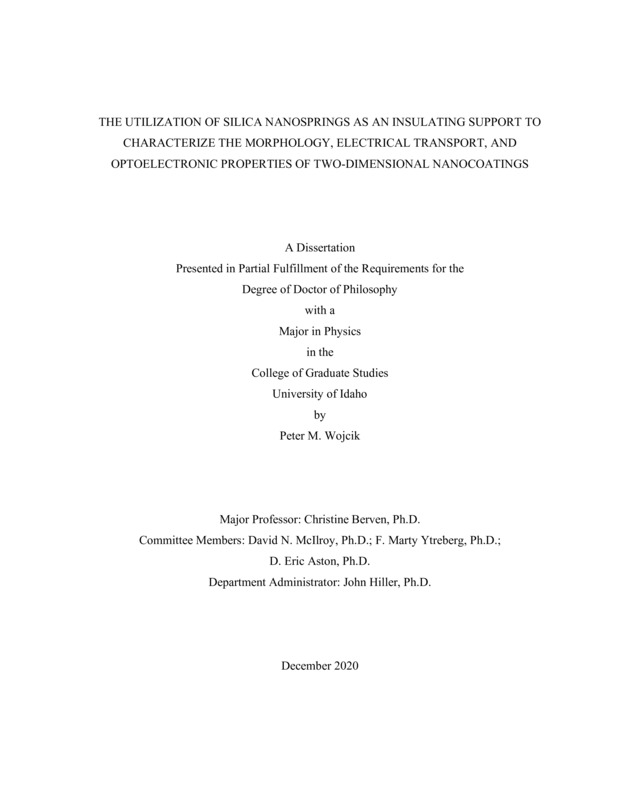The Utilization of Silica Nanosprings as an Insulating Support to Characterize the Morphology, Electrical Transport, and Optoelectronic Properties of Two-Dimensional Nanocoatings
Wojcik, Peter. (2020-12). The Utilization of Silica Nanosprings as an Insulating Support to Characterize the Morphology, Electrical Transport, and Optoelectronic Properties of Two-Dimensional Nanocoatings. Theses and Dissertations Collection, University of Idaho Library Digital Collections. https://www.lib.uidaho.edu/digital/etd/items/wojcik_idaho_0089e_12009.html
- Title:
- The Utilization of Silica Nanosprings as an Insulating Support to Characterize the Morphology, Electrical Transport, and Optoelectronic Properties of Two-Dimensional Nanocoatings
- Author:
- Wojcik, Peter
- ORCID:
- 0000-0002-2125-5702
- Date:
- 2020-12
- Program:
- Physics
- Subject Category:
- Physics; Materials Science; Condensed matter physics
- Abstract:
-
This dissertation explores the nucleation, evolution, and growth dynamics of silica nanosprings and the utilization of silica nanosprings as an insulating support to characterize the morphology, electrical transport, and optoelectronic properties of two-dimensional nanocoatings. The primary results of this research are threefold. First, we identify the mechanisms of initial formation and growth dynamics of silica nanosprings. Second, we coat the surface of silica nanosprings with a novel conductive carbon to create a core–shell structure and definitively identify that the conductive carbon is a nanocrystalline graphitic layer consisting of an agglomeration of carbon nanospheres formed by the accretion of graphitic flakes. Third, we observe the photoconductive behavior of a single ZnO-coated silica nanospring, present models to explain the photoconduction and recombination mechanisms responsible for the observed sub-bandgap photocurrent rise and decay behavior, and present a phenomenological model to describe the characteristics of the saturation photocurrent dependence on excitation intensity. A single silica nanospring is composed of multiple individual amorphous silica nanowires bound together via a common catalyst to form a larger, well-defined helical structure with a wire diameter of ~70–500 nm, an outer diameter of ~200–1000 nm, and lengths on the order of hundreds of microns. Until now, the initial phases of formation and growth dynamics of this type of silica nanospring had not been explored. We find that the low-temperature growth conditions facilitate the formation of an asymmetrically-shaped gold catalyst. A row of silica nanowires is formed in an energetically favorable process beneath the gold catalyst. The varying growth rates of the individual nanowires produce an asymmetry in the interfacial surface tension and a corresponding variable work of adhesion along the outer boundary of the catalyst–nanowires interface. The variable work of adhesion provides the asymmetry necessary for the catalyst’s helical precession, which subsequently produces the silica nanospring’s helical morphology. The surface of silica nanosprings can be coated with an assortment of conducting and semiconducting materials to create a multifunctional nanomaterial that can be utilized in a wide variety of applications. One of these conducting materials, referred to as graphite from the University of Idaho thermolyzed asphalt reaction (GUITAR), has been coated onto silica nanosprings, and its structural and electrical properties have been investigated. Using a silica nanospring as a platform for GUITAR has allowed, for the first time, transmission electron microscopy images of a GUITAR coating that fully reveal its morphology. Images of a GUITAR coating obtained from scanning electron microscopy, transmission electron microscopy, and atomic force microscopy, together indicate that a GUITAR coating on a silica nanospring is a ~100 nm thick layer composed of an agglomeration of carbon hemispheres ~50–100 nm in diameter formed by the accretion of graphitic flakes ~1–5 nm in diameter. A Raman spectroscopic analysis of GUITAR and the measurements of the electrical resistivity and temperature coefficient of resistivity of 11 single GUITAR-coated silica nanospring electrical devices indicate that GUITAR is a form of nanocrystalline graphite. Polycrystalline ZnO was coated onto silica nanosprings using atomic layer deposition, and an electrical device consisting of a single ZnO-coated silica nanospring was fabricated and used to investigate the optoelectronic properties of the ZnO layer using near-ultraviolet (405 nm) and sub-bandgap (532 and 633 nm) excitation. The photocurrent responses of all three excitation sources display a typical two-step fast and slow rise and decay response. Physical models are presented and propose that the photocurrent rise and decay characteristics depend on the excitation energy and the trapping of electrons and holes in intermediate defect levels within the bandgap. A phenomenological model is presented to explain the breaks in the slopes of the saturation photocurrent versus excitation intensity profile for each excitation source. We find that these slopes are a function of the transition probabilities of defect states, the number of carriers available to populate the conduction (valence) band, and the rate at which electrons and holes recombine.
- Description:
- doctoral, Ph.D., Physics -- University of Idaho - College of Graduate Studies, 2020-12
- Major Professor:
- Berven, Christine
- Committee:
- McIlroy, David N; Ytreberg, Marty; Aston, Eric
- Defense Date:
- 2020-12
- Identifier:
- Wojcik_idaho_0089E_12009
- Type:
- Text
- Format Original:
- Format:
- application/pdf
- Rights:
- In Copyright - Educational Use Permitted. For more information, please contact University of Idaho Library Special Collections and Archives Department at libspec@uidaho.edu.
- Standardized Rights:
- http://rightsstatements.org/vocab/InC-EDU/1.0/

